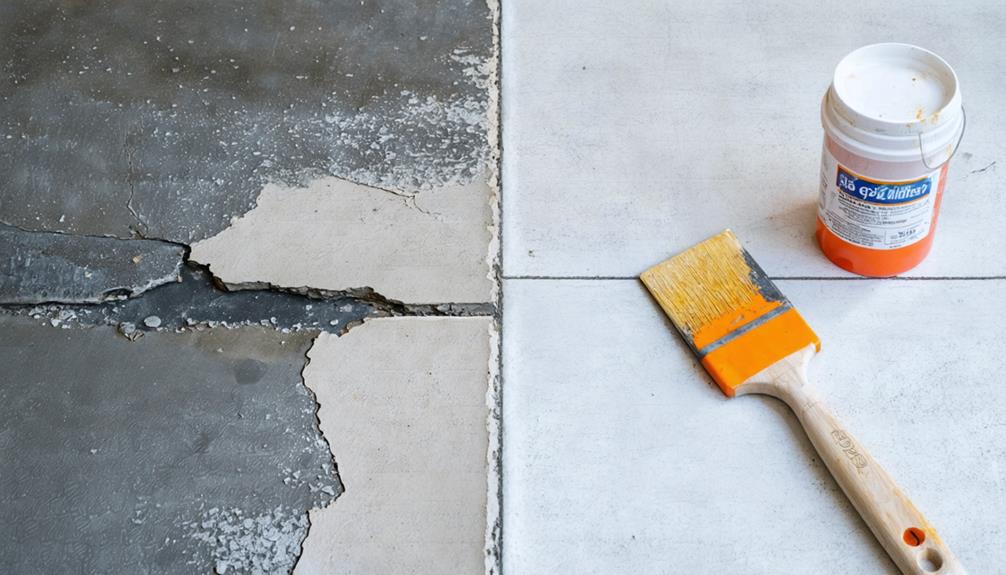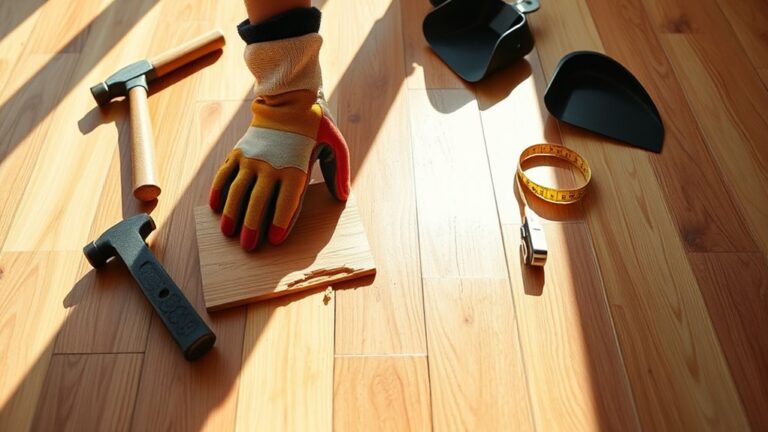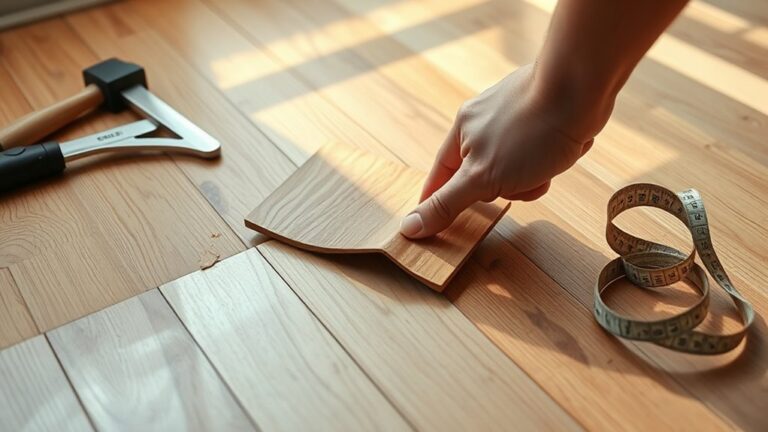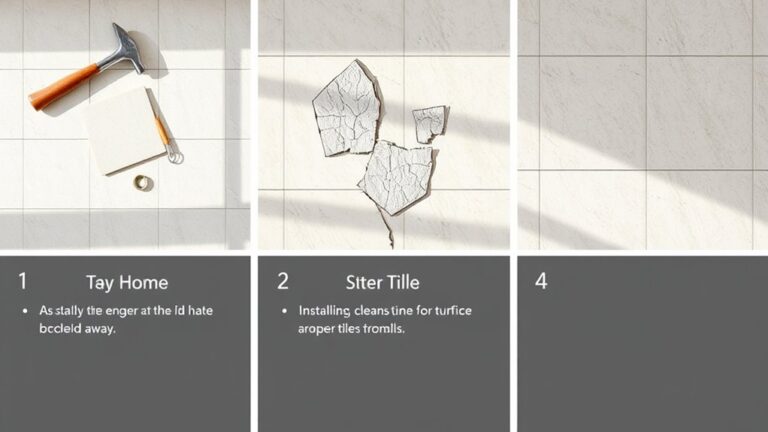To prevent and repair concrete floor spalling, start by using high-quality, air-entrained concrete and implementing proper curing techniques. Ascertain moisture is minimized to combat freeze-thaw cycles, especially in vulnerable areas. Regular inspections help identify early signs of spalling, allowing for timely repairs. For repair, clean the spalled area thoroughly, widen cracks for better filling, and use appropriate repair products. Applying a penetrating waterproofing sealer can also protect against moisture intrusion. By following these guidelines, you'll enhance your concrete's durability and longevity, and there's more to discover that can keep your floors in top condition.
Overview of Concrete Spalling
Concrete spalling is a common issue that affects many structures, resulting in visible damage that can range from minor pitting to severe flaking. This deterioration can occur in concrete surfaces of any age and is often a sign of underlying problems. When you notice spalling, it's essential to act quickly to prevent further damage that could lead to costly repairs and compromised structural integrity.
The effects of spalling can manifest as trip hazards, making it important to address these issues promptly. Repairing spalled areas typically involves resurfacing, which costs between $3.00 to $5.00 per square foot. Consequently, understanding how to prevent spalling is critical for maintaining the durability of your concrete surfaces.
To effectively prevent spalling, start by using high-quality concrete mixes designed to withstand environmental stressors. Proper curing techniques also play a significant role in ensuring concrete reaches its ideal strength. Additionally, regular maintenance and inspections can identify potential issues before they escalate. Applying penetrating sealers can protect your concrete from moisture infiltration, one of the primary contributors to spalling.
Causes of Concrete Spalling
Concrete spalling can often be traced back to freeze-thaw cycles, which occur when water seeps into the concrete, freezes, and expands, causing cracks. Additionally, corrosion of the reinforcement steel due to moisture and oxygen exposure can lead to further deterioration as the expanding rebar exerts pressure on the surrounding concrete. Understanding these causes is key to preventing spalling and maintaining the integrity of your concrete surfaces.
Freeze-Thaw Cycle Effects
During harsh winter months, the freeze-thaw cycle poses a vital threat to the integrity of concrete surfaces. When water absorbed in the concrete freezes, it expands, creating internal pressure that can lead to surface cracking and spalling concrete. Each freeze-thaw cycle induces micro-cracks, which accumulate over time, increasing the likelihood of more severe damage.
Areas with high moisture content are particularly vulnerable; the repeated freezing and thawing exacerbates deterioration. In regions experiencing more than 50 freeze-thaw cycles annually, concrete spalling becomes a major concern, especially if you haven't implemented proper preventive measures.
To combat this issue, consider using air-entrained concrete mixes. These mixes incorporate tiny air pockets that allow for expansion and contraction, reducing the risk of surface damage. Additionally, it's essential to prevent water from penetrating the concrete in the first place, as moisture is the main contributor to freeze-thaw damage. By understanding these effects and taking proactive steps, you can greatly enhance the longevity and appearance of your concrete surfaces, ensuring they withstand the harsh winter conditions.
Corrosion of Reinforcement Steel
The integrity of concrete can be severely compromised by the corrosion of reinforcement steel, a primary cause of spalling. When moisture and oxygen penetrate the concrete, they react with the steel, leading to rust formation. This rust expands, creating internal pressure that can crack and spall the concrete surface. The presence of chlorides, often from deicing salts or seawater, greatly accelerates this corrosion process, putting your concrete structures at risk.
As the reinforcement steel corrodes, it can lose up to 50% of its cross-sectional area before you even notice spalling. This loss directly undermines the structural integrity of your concrete. To combat this issue, effective waterproofing and sealing of concrete surfaces are vital. A good waterproofing sealer can greatly reduce moisture intrusion, thereby hindering the onset of corrosion.
It's also important to conduct regular inspections and maintenance of your concrete structures. By identifying early signs of corrosion, you can intervene before spalling becomes extensive, preserving both the longevity and the safety of your concrete installations. Stay proactive to protect your investments and guarantee the durability of your concrete floors.
Impacts of Spalling on Structures
Spalling can considerably impact both the aesthetic appeal and safety of your structures. You may notice visible damage that detracts from the overall appearance, while areas affected by spalling can create trip hazards, increasing the risk of accidents. Additionally, deep spalling raises serious concerns about the structural integrity of your concrete elements, potentially leading to costly repairs or even catastrophic failures.
Aesthetic Deterioration and Appeal
Concrete surfaces that exhibit spalling can greatly undermine the aesthetic appeal of a property. The visible pits, flakes, and uneven textures detract from the overall appearance, leading to aesthetic deterioration that may turn potential buyers away. This damage not only impacts curb appeal but can also lower property value considerably.
In commercial settings, the consequences are even more pronounced. A spalled concrete surface can create a less professional image, affecting customer perceptions and potentially harming your business reputation. Addressing spalling early is vital because initial cosmetic damage can escalate into more extensive and costly repairs, further compromising the aesthetic integrity of your structure.
Here's a quick comparison of the impacts of spalling on aesthetics:
| Impact | Description |
|---|---|
| Property Value | Visible damage leads to decreased market appeal. |
| First Impressions | A spalled surface creates a negative initial impact. |
| Commercial Appeal | Unprofessional appearance may deter customers. |
| Repair Costs | Early cosmetic issues can evolve into expensive repairs. |
Taking proactive steps in repairing spalled concrete can help preserve the visual quality of your property.
Safety Hazards and Risks
A deteriorating concrete floor can pose significant safety hazards, especially in environments with high foot traffic. Spalled areas create trip hazards that increase the risk of accidents and injuries. When you ignore these issues, you're not only risking personal safety but also potentially compromising the structural integrity of your building.
Exposed steel reinforcement due to spalling can corrode, further weakening the concrete and elevating the risk of collapse, particularly in load-bearing structures. Deeper spalling can lead to moisture penetration, exacerbating deterioration and allowing mold growth, which poses health risks to occupants.
You need to be proactive about identifying spalled areas and addressing them promptly. There are various repair options available, ranging from surface treatments to complete resurfacing. By taking action early, you can mitigate trip hazards and safeguard the structural integrity of your concrete floors.
Ultimately, neglecting spalling not only affects safety but can also diminish property value and tenant satisfaction. Verify you prioritize maintenance to keep your concrete floors safe, functional, and visually appealing.
Structural Integrity Concerns
Often overlooked, structural integrity concerns arising from spalling can have serious implications for any building. Spalling leads to compromised structural integrity, as deep surface damage increases the risk of cracks and crumbling. If not addressed promptly, this could even result in structural collapse. The exposed rebar within the concrete becomes susceptible to corrosion, exacerbating the deterioration and necessitating a more costly and extensive repair process.
To illustrate the impacts of spalling, consider the following:
| Impact Type | Description | Financial Implication |
|---|---|---|
| Structural Damage | Increased risk of cracks and potential collapse | Escalating repair costs |
| Safety Risks | Trip hazards for pedestrians and vehicles | Liability concerns |
| Corrosion of Rebar | Weakened structural elements due to moisture | Higher long-term repair costs |
| Moisture Penetration | Accelerated internal stress and deterioration | Need for urgent repairs |
Addressing spalling isn't just about aesthetics; it's essential for maintaining structural integrity. Regular inspections and timely repairs can help prevent moisture penetration and guarantee the longevity of your concrete surfaces.
Repair Techniques for Spalling
Repairing spalling requires careful preparation to secure the longevity and effectiveness of the repair. Start by confirming thorough surface preparation, which involves cleaning the existing concrete to remove dust and debris. Tools like shot blasters or Nyalox wheels are essential for achieving ideal adhesion of your chosen patching materials.
When dealing with larger spalls, it's important to widen the cracks using grinders or chisels. This step not only allows for better filling but also guarantees that the repair depth is at least half an inch, which is essential for ideal results. Additionally, create a key at the edges of the spalled area. This technique enhances the bonding of the patching materials, leading to a more durable repair.
Selecting the appropriate fillers or sealants is critical and should be based on the specific conditions of the concrete surface. Use recommended tools to apply these materials for the best results. If the extent of the spalling is significant, you might want to consult with professionals or hire certified contractors. Their expertise guarantees adherence to industry standards and secures high-quality workmanship in the repairs.
Prevention Strategies for Spalling
Effective prevention strategies for concrete floor spalling focus on minimizing moisture intrusion and enhancing durability. One key approach is to apply a penetrating waterproofing sealer at least 28 days after concrete placement. This application greatly reduces moisture intrusion, a common culprit in spalling. To maintain this protective barrier against water absorption and deicing salts, it's essential to reapply sealers every few years.
Another effective method is to utilize an air-entrained concrete mix. This specialized mix improves freeze-thaw resistance, making your concrete less susceptible to damage in climates with extreme temperature fluctuations. Proper curing techniques are also essential; maintaining adequate moisture and temperature during the curing process helps achieve maximum concrete strength and durability.
Additionally, installing adequate control joints can effectively manage cracking and stress in your concrete. By allowing for movement, these joints minimize the risk of spalling, especially in high-traffic areas where wear and tear are more pronounced.
Incorporating these strategies into your concrete maintenance plan will greatly enhance its longevity and resilience. By taking proactive steps to prevent concrete spalling, you can create a durable surface that withstands the elements and daily use. Remember, a little effort in prevention today can save you from costly repairs tomorrow.
Maintenance Best Practices
Incorporating robust maintenance practices is essential for preserving the integrity of your concrete floors and preventing spalling over time. Regular inspections are vital; check for early signs of spalling, like pitting or flaking. Identifying these issues early allows for timely intervention, reducing potential repair costs.
Applying a penetrating waterproofing sealer within 28 days of concrete placement is another key step. This creates a moisture barrier that prevents water infiltration, a major contributor to spalling. Don't forget that routine maintenance includes reapplying sealers every few years. This protects your concrete from environmental factors like moisture and freeze-thaw cycles that can lead to damage.
Proper curing techniques during the initial setting period greatly enhance the durability of your concrete. Confirm you follow recommended curing practices to improve the concrete's resistance to spalling. Additionally, if you live in a freeze-thaw environment, consider utilizing air-entrained concrete mixes. These mixes incorporate tiny air bubbles that allow for expansion and contraction, reducing the risk of spalling caused by water freezing and thawing.
Understanding Spalling Repair Products
Understanding spalling repair products is vital for maintaining the longevity and appearance of your concrete surfaces. When dealing with spalling, selecting the right repair products can make all the difference. For example, products like Overlay MixRestore and MT Resurfacer are specifically formulated for resurfacing spalled areas, effectively rejuvenating large sections with a half-inch overlay. Quick-setting repair mixes are also available, allowing for immediate restoration, which minimizes downtime on surfaces like driveways and patios.
It's important to evaluate the severity of the spalling when choosing patch compounds. If the spalled area is less than one-third of the thickness, you can typically patch it. However, extensive damage may necessitate complete removal and replacement. Polymer-modified products are particularly useful in these cases, as they enhance bonding strength and durability, making them ideal for deeper spalls.
Always follow the manufacturer's mixing and application instructions to guarantee peak performance and longevity of your repair products. Skipping this step can lead to ineffective repairs and further deterioration of your high-quality concrete surfaces. By understanding the specific needs of your concrete, you can choose the most appropriate repair products that will not only address spalling effectively but also extend the life of your surfaces. Investing time in selecting the right materials will pay off, helping you maintain your concrete's aesthetic and structural integrity for years to come.
Staying Updated on Concrete Care
Keeping up with the latest advancements in concrete care is essential for anyone looking to maintain the integrity and appearance of their surfaces. By staying informed, you can effectively combat issues like spalling caused by factors such as deicing salts and the cycles of freezing and thawing. Here are three key strategies to help you stay updated:
- Subscribe to Newsletters: Regularly reading industry newsletters can provide insights on the most effective products and techniques for concrete repair. This information can help you make informed decisions about your concrete maintenance.
- Engage on Social Media: Follow social media channels that focus on concrete care. These platforms often share tips, visual guides, and real-life experiences from others in the community. This shared knowledge can enhance your understanding of how to effectively care for your concrete surfaces.
- Access Educational Resources: Utilize articles and videos that discuss best practices for maintaining concrete. These resources can help you learn about new technologies and materials that can improve durability and aesthetics, ultimately helping prevent spalling.
Additionally, regularly checking for updates from concrete care professionals guarantees that you're aware of the latest innovations in the field. Engaging with local contractors or concrete specialists can also provide tailored advice based on your region's climate conditions and common spalling causes. By implementing these strategies, you'll be well-equipped to maintain your concrete surfaces and address any potential issues proactively.
Frequently Asked Questions
How to Prevent Concrete From Spalling?
To prevent concrete from spalling, you need to address spalling causes effectively. Start with moisture control; guarantee your concrete mix includes air-entrained components to withstand freeze-thaw cycles caused by temperature fluctuations. Implement surface treatments like penetrating sealers after curing, and maintain regular inspections to catch any cracks early. Avoid using deicing salts, as they can chemically react with the concrete, increasing the risk of surface deterioration and spalling.
Can Spalling Concrete Be Repaired?
Yes, spalling concrete can be repaired effectively. You'll need to identify spalling causes to choose the right repair techniques. Surface preparation is essential; power washing and cleaning guarantee proper adhesion for patch compounds or overlays. For minor damage, patching works well, while resurfacing is better for larger areas. Consider long-term solutions like quick-setting repair mixes for immediate restoration, but if damage is severe, complete concrete restoration might be necessary.
What Is the Best Concrete Sealer to Prevent Spalling?
As the saying goes, "an ounce of prevention is worth a pound of cure." When it comes to choosing the best concrete sealers for spalling prevention, look for penetrating sealers that offer moisture control and long-term protection. Proper surface preparation is essential before sealant application, as it guarantees maximum adhesion. Silane or siloxane-based products are highly effective, providing a durable barrier against water and deicing chemicals while allowing the concrete to breathe.
Will Sealing Concrete Stop Spalling?
Sealing concrete won't completely stop spalling, but it offers significant sealing benefits. By enhancing moisture control, you reduce the risk of freeze-thaw damage, which is essential for surface durability. A well-applied sealer also improves freeze-thaw resistance, extending the life of your concrete. Plus, it provides aesthetic enhancement, making your surfaces look better while protecting them. Regular maintenance and reapplication are key to maintaining these advantages and minimizing spalling risks over time.




